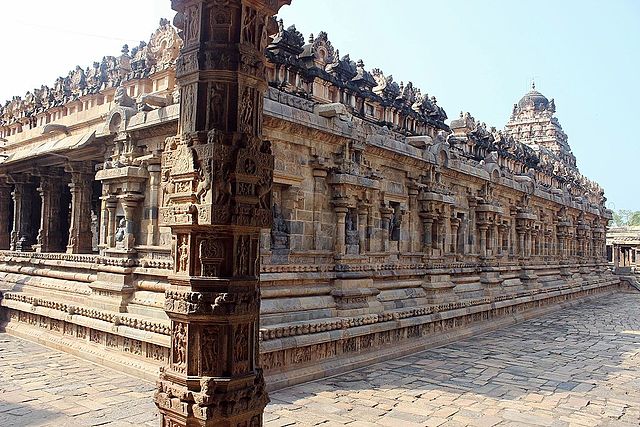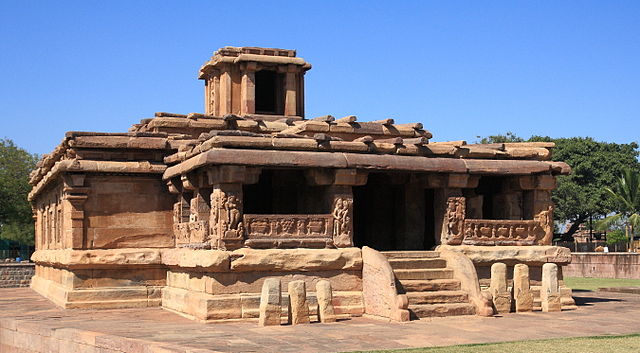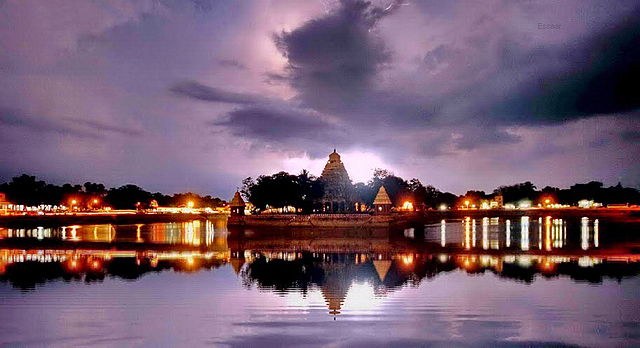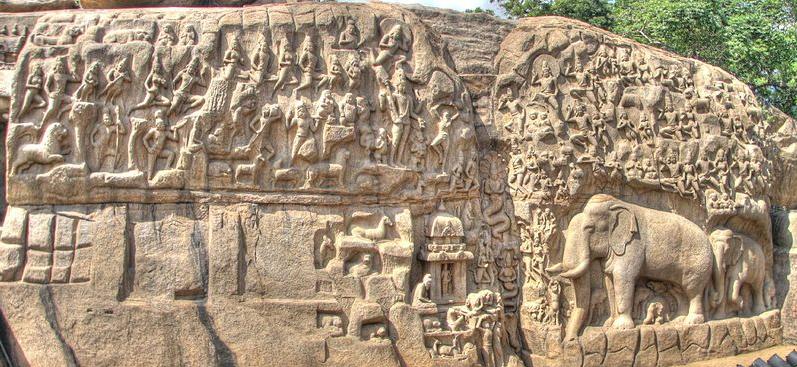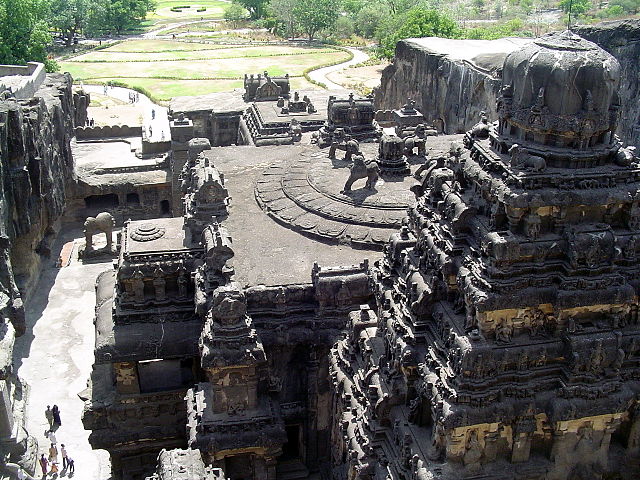The Dravidian style of Architecture is the characteristic South Indian style and is mainly found in the Southern Indian states of Tamil Nadu, Karnataka, Kerala, Telangana, and Andhra Pradesh. The Dravidian architecture can mainly be seen through the temples; which were of various shapes such as square, rectangular, octagonal, star-shaped etc and they were made from stones. They were constructed by sandstone, steatite or granite. The Vastu Shastra, an ancient science of architecture and construction, states it as one of the three styles of temple building.
The Dravidian style temples inhere almost universally of four parts. They differ only according to the age in which they were constructed. The main part, contained the hall where the image of the god or his symbol was placed, the temple itself was called the Vimana. It was always constructed square in plan and on top of it was a pyramidal roof of one or more levels. A pillared outdoor hall or pavilion for public rituals, known as Mandapas (or porches) was built to cover and precede the door leading to the main hall where the deity was kept. The primary features in the quadrangular enclosures that surrounded the more remarkable temples were the gate-pyramids known as Gopurams. These rectangular, pyramidal towers were often 50 metres high with intricate sculptures of gods, demons, humans, and animals on them. Pillared halls (Chaultris) used for several processes were the unvarying appendage to the Dravidian temples. The most holy place was the pitha (altar), or plinth, of the Deity.
The altar was located in the sanctum sanctorum (inner sanctum) which was known as the garbha-griha meaning womb house. There were no sculptures, but that of the main deity in the garbha-griha or inner sanctum of the main shrine. The gateway that faced the sanctum was called mahadvara and was the main entrance to the temple.
There had to be a significant ceremony known as impregnating (garbhadhana or garbha-nyasa) before the construction of the garbha-griha and so that part of the temple was built first. The sanctum sanctorum (central shrine) was topped by a pyramidal tower several stories high called vimana or sikhara. It was crowned by a chakra in a Lord Vishnu temple and a trident in a Lord Siva temple.
The garbha-griha and the pavilion in front of the main altar was connected by a vestibule or porch called ardha mandapa or antarala.
In front of the sanctum (mukha mandapa), there used to be a hall (usually of rectangular shape) where the devotees stood to be able to see the main deity of the temple. The nityarchana mandapa is where the worship of the small (moveable) representative of the main deity is done every day. There used to be a flight of stairs to connect the first prakara with the sanctum sanctorum and was called sopana. It was in front of this flight of stairs where the main mandapa was.
The other deities and the consort of the main deity (Lakshmi or Parvati) were kept in the subsidiary shrines or altars.
Many of the Dravidian temples had halls for various purposes. For example, hall for holding large audience- ranga-mandapa, hall for occasional sacrifices-yajna, hall for dance recitals- nritya-mandapa, hall for marriage ceremonies- kalyana-mandapa, hall in the middle of the temple tank used for festivals- vasanta-mandapa, hall for festive occasions- utsava-mandapa, place where the festival vehicles were kept- vahana-mandapa and asthana-mandapa- where the processional deity held alankara-mandapa where the deity was dressed before being taken on cavalcade.
There also used to be a treasury, a kitchen (paka-sala), store room (ugrana), dining hall (Ramanuja-kuta in a Vaishnava temple and Siva-kuta in a Siva temple) in such temples.
In the temple ground, outside the main entrance of the garbha- griha was the flagpost (dhvaja- stambha) and a platform for food offerings (bali-pitha). Every temple usually had a temple tank (teppakulam), flower garden (nandavana), and temple chariot (ratha). On festival days the processional deity was cavalcaded around town on the chariot. Thousands of people joined the festival parade with zest.
Several empires and kingdom of Southern India imprinted their influence on architecture.
The Sangam period (from 300BCE -300CE), made brick shrines for the deities Murugan, Shiva, Amman and Thirumal (Vishnu) of Tamil pantheon. One of the temples, the Saluvannkuppan Murukan Temple was built in three layers; the lowest layer consisted of the brick shrine. As the dynasties expanded, various structural additions, such as sculptures of art, nature and deities, were made to the brick shrines. Some examples of these additions can be seen in the Madurai Meenakshi Amman Temple and the Srirangam Ranganathaswamy Temple from the Sangam period.
The Pallavas (from 600-900 AD) are considered the pioneers of South Indian architecture. Their greatest work of art was the construction of single rock temples in Mahabalipuram and Kanchipuram, which are now part of Tamil Nadu. The Dravidian style temples were initially built in the Badami Chalukya – Pallava period. Rock – cut temples were made between 610 CE and 690 CE and the structural temples were built between 690 CE – 900 CE. They made pillared halls and monolithic shrines known as rathas in Mahabalipuram. Not only did the Pallavas pioneer in the construction of the rock cut temples (without using building materials like mortar, bricks etc), rather it was them who started constructing large temples and very large deities and idols. The Thiruppadagam and Thiruooragam temples have images of Lord Vishnu which are 28 and 35 feet high respectively in his expression of Pandavadhootar and Trivikraman. Dravidian style of architecture was prevalent in the whole of Tamil Nadu.
The Pandya built a 12 tiered temple; the Srivilliputtur Andal Temple, which is also the official symbol of the government of Tamil Nadu. Its tower is 192 feet high; which is almost equal to 59 meters high. The famous Meenakshi temple in Madurai is another example of the temples built in this period.
The Cholas were very creative temple builders; The Brihadeshvara Temple of Thanjavur, Brihadeshvara Temple of Gangaikonda Cholapuram, the Airavatesvara Temple of Darasuram are the temples which have been given the title of ‘ Great Living Chola Temples ‘ among the UNESCO World Heritage Sites. The Sarabeswara (Shiva) Temple, also known as the Kampahareswarar Temple at Thirubhuvanam, is yet another magnificient temple built by the Chola dynasty.
The Rastrakutas ruled in the period 753 – 973 CE. They built beautiful Dravidian monuments at Ellora and Elephanta (now known as Maharashtra), such as the Jaina Narayana Temple, Navalinga Temple and the Kailasanatha temple, in the rock cut architecture style. The Rastrakutas constructed 34 temples; all in the rock – cut style. The walls of the temple have sculptures from the Hindu mythology depicting the Dravidian art. The ceilings, too, have beautiful paintings.
The Chera style of architecture is only one of its kind in Dravidian architecture. The Thirunelli Temple, the Vadakkunnathan Temples, Kodungallur Bhagavathy Temple and Kandiyur Siva Temple are its examples.
Thus we can see that South India has wonderful works of Dravidian architecture worth watching.


